Место специјалних школа у инклузивном образовању
The place of special schools in inclusive education
Author(s): Gordana Nikolić, Dejan Đorđić, Jasmina KovačevićSubject(s): Social Sciences, Education, Inclusive Education / Inclusion
Published by: Филозофски факултет, Универзитет у Приштини
Keywords: special schools; inclusive education; outcomes; ecosystem
Summary/Abstract: The role of schools for the education of students with disabilities is associated with the context of inclusive education in different ways. On the one hand, they are accepted as institutions that, in their full capacity, can and should support education and social inclusion, while another approach considers that further existence of these schools is a reflection of the lack of the inclusion process. The aim of this paper is to determine the role of these schools and the changes that have occurred in their work since 2009, when inclusive education was introduced into the Serbian educational system. The sample covered all 48 schools for the education of students with disabilities on the territory of the Republic of Serbia. For the needs of the research, a questionnaire for collecting data from these schools was prepared at the Institute for the Improvement of Education. The results showed that the network of these institutions has not changed, but that users have changed at all levels of education, since these schools now educate children with several types of disabilities. The number of defectologists is higher in Belgrade and Vojvodina than in the rest of Serbia, (p <0,05), while the number of defectologists, who only provide support to other schools, is the largest in Vojvodina, (p <0,05). Student achievement indicators show that 56,95% of pupils adopt elementary educational achievements and life skills useful in everyday activities. The inclusion of pre-school children is higher in Vojvodina (M = 6,83) and Belgrade (M = 6,71), compared to the rest of Serbia (M = 3,37). Horizontal movements show that the transition of pupils from regular to special school is 8.4 times more frequent than in the period before the inclusion law. Further research directions in this area could include the implementation of several different ways of assessing the approach that underpins early childhood development for their easier access to kindergartens and primary schools, as well as the examination of circumstances that would increase transition from special to regular schools.
Journal: Зборник радова Филозофског факултета у Приштини
- Issue Year: 49/2019
- Issue No: 1
- Page Range: 277-297
- Page Count: 21
- Language: Serbian

